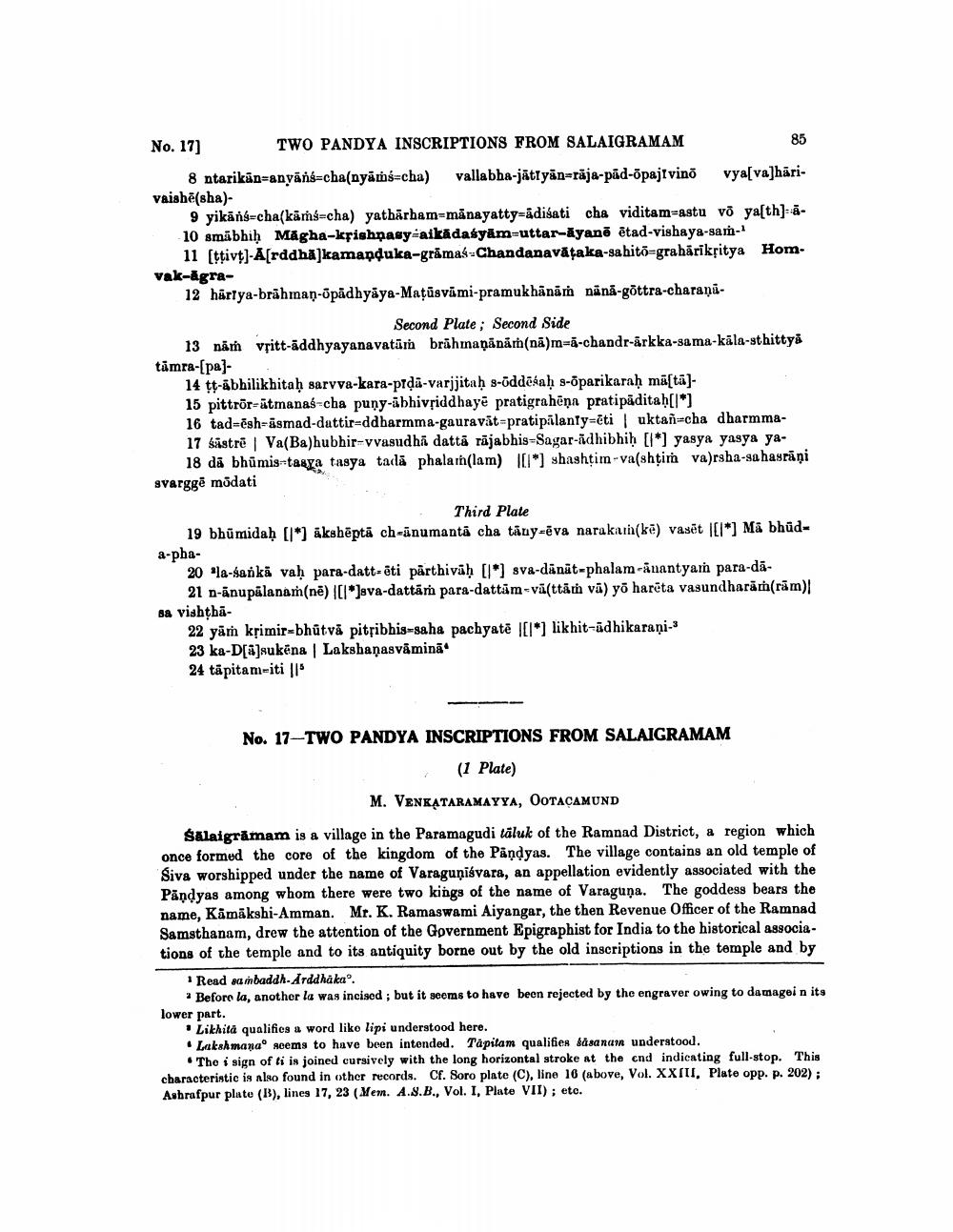________________
No. 17]
TWO PANDYA INSCRIPTIONS FROM SALAIGRAMAM 8 ntarikān=anyāns-cha(nyams=cha) vallabha-jātīyān=rāja-păd-õpajivino vya[va]hārivaishē(sha)
9 yikāng=cha(kāms=cha) yathārham=mānayatty=&disati cha viditam=astu võ ya[th]-a10 smūbhih Magha-krishnasy aikādaśyām uttar-yanō ētad-vishaya-sam
11 (ttivt)-A[rddhā]kamapduka-grāmas-Chandanavăţaka-sahitõ=grahārīksitya Homvak-agra12 hártya-brāhmaṇ-opādhyaya-Maţāsvāmi-pramukhānam nână-göttra-charani
Second Plate; Second Side 13 năm vșitt-addhyayanavatām brāhmaṇānăm(nā)m=ā-chandr-arkka-sama-kāla-sthittyä tämra-{pa)
14 tt-abhilikhitaḥ sarvva-kara-peda-varjjitah s-oddēšah s-parikaraḥ mā[tā). 15 pittrör-atmanaś-cha puny-abhivriddhaye pratigrahēņa pratipăditah[l*) 16 tad-eshasmad-dattiraddharmma-gauravat-pratipälanty=ēti uktan=cha dharmma17 sastrē | Va(Ba)hubhir-vvasudha dattā rājabhis-Sagar-adhibhiḥ [I*) yasya yasya ya
18 dá bhumis-tasya tasya tada phalar(lam) Ill*) shashtim-va(shțim va)rsha-sa hayrāņi svargge modati
Third Plate 19 bhūmidah [l*) Akshēptā ch-inumanta cha tany=ēva narakan(kē) vasēt IEI*] Má bhüda-pha
20 "la-sankā vah para-datt-ēti parthivih [l*) sva-danat-phalam-åuantyam para-da
21 n-ánupālanaṁ(ne) (Java-dattár para-dattam-västtäm va) yo harēta vasundharam(rām) sa vishthā
22 yam ksimir-bhūtvä pitsibhis-saha pachyatë [l*) likhit-ūdhikarani23 ka-D[a]sukēna Lakshanasvăminā 24 täpitam-itill
No. 17-TWO PANDYA INSCRIPTIONS FROM SALAIGRAMAM
(1 Plate) M. VENKATARAMAYYA, OOTACAMUND
salaigrāmam is a village in the Paramagudi taluk of the Ramnad District, a region which once formed the core of the kingdom of the Pandyas. The village contains an old temple of Sive worshipped under the name of Varaguņiśvara, an appellation evidently associated with the Pandyas among whom there were two kings of the name of Varaguņa. The goddess bears the name, Kämākshi Amman. Mr. K. Ramaswami Aiyangar, the then Revenue Officer of the Ramnad Samsthanam, drew the attention of the Government Epigraphist for India to the historical associations of the temple and to its antiquity borne out by the old inscriptions in the temple and by
1 Read sa mbaddh-Arddhakao.
* Before la, another la was incised; but it seems to have been rejected by the engraver owing to damagein its lower part.
· Likhita qualifies a word like lipi understood here. • Lakshmanao seems to have been intended. Täpitam qualifies sasaran understood.
• The i sign of li is joined cursively with the long horizontal stroke at the end indicating full-stop. This characteristic is also found in other records. Cf. Soro plate (C), line 16 (above, Vol. XXIII, Plate opp. p. 202): Ashrafpur plate (B), lines 17, 23 (Mem. A.S.B., Vol. I, Plate VII); etc.




